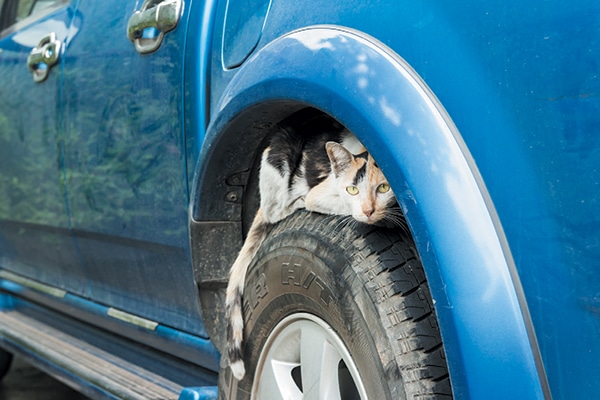We love our cats, so why in the world would we expect them to cope with the harsh realities of life outside? Defenders maintain that there’s a tradeoff, but studies report that indoor-only cats live several years longer than cats who sometimes navigate life outside. Here’s more on the case for indoor cats vs. outdoor cats:

Photography by amstockphoto/Thinkstock.
When Did Indoor Cats vs. Outdoor Cats Become an Issue?
Sixty years ago, indoor cats vs. outdoor cats wasn’t an issue. Most cats came and went as they pleased. It wasn’t welfare issues that changed their world, encouraging more indoor cats in the U.S. — it was the arrival of mass-manufactured scoopable clumping cat litter. Back in the feline dark ages, litter boxes weren’t sold either. Some cat caretakers improvised with plastic dishpans or even cooking pans filled with anything from coal to dirt, but cats mostly did their business outside. When it became clear that most cats would use manufactured litter, more cats were eventually transitioned to life indoors.
The advent of manufactured cat litter and boxes meant that cats could more easily be kept as indoor pets. And within only a few years, cats took over their canine cousins as America’s most popular pet.
Back in 1994, after writing a popular book, The Tribe of Tiger, author Elizabeth Marshall Thomas, who was in rural New Hampshire, told me, “Choice is very important (as to whether to go indoors and outdoors). I feel cats should control their own destinies, even if there’s some risk; live by the sword, die by the sword.” In the 1990s these comments weren’t particularly controversial.
By 2004 just over half of all U.S. cats were kept strictly indoors, nearly twice the number of 20 years prior. According to the American Pet Product Association’s National Pet Owners Survey, in 2004 about a third of all cats could go inside or outside as they pleased, with the remaining 17 percent outside only. By 2014, about 70 percent are defined as indoor only, with about 25 percent inside or outside as they desire, with the remaining five percent described as outside only.
Still, when you do the math, millions of cats continue to have the option to wander outdoors. With some, it’s because the cats — who perhaps have been outdoors for their lifetime and taken inside — still demand to go outside. Not wanting a feline temper tantrum, cat caretakers relent.
Outdoor Cats Can Get Hit or Harmed By Cars
Some cat parents insist that nothing bad can happen to their kitty outdoors — but that’s just untrue. While there are still rural places in the U.S. without nearby roads and lots of cars, those locations remain the exception. Still, many insist their cats are too clever to get in the way of a car. But it turns out that, according to the National Traffic Safety Administration, 5.4 million cats are hit by cars each year in the United States, and 97 percent of those cats die. There’s no data to reveal how many of these cats are owned or unowned, but these numbers clearly demonstrate that the notion that cats are too ingenious to get hit by cars is a myth.
And getting hit isn’t the only car hazard. In cold weather, cats seek heat, and slinking under a car hood can be a feline version of an electric blanket — until an unknowing driver starts the car.
A few licks of sweet-tasting antifreeze can kill a cat, unless it’s a pet-safe product.
Cats can also nibble on plants treated with pesticides or plants that may be tasty but are also toxic.
Outdoor Cats Are Prone to Diseases from Ticks and Mosquitos, Like Heartworm
Another myth about outdoor cats is that they aren’t prone to tick disease. While Lyme disease may not make cats ill, there’s plenty that’s delivered by the bloodsuckers that can: cytauxzoonosis (sometimes called bobcat fever), ehrlichiosis, haemobartonellosis, babesiosis and tularemia. Using a veterinary tick protection, tick disease might be prevented, and the same to stop flea bites that can also cause disease.
Mosquitoes carry heartworm, and the American Heartworm Society points out that all cats should be protected, as mosquitoes do get indoors. You’d think that all cats going outdoors would receive protection, but few do. In cats, heartworm can cause heartworm associated respiratory disease (creating asthma-like symptoms), and heartworm is one of the most common causes of sudden death in cats.
While heartworm treatment is uncomfortable (and expensive) for dogs, in cats there’s a larger problem — there’s no treatment for heartworm (short of prevention).
Other Animals Can Injure or Kill Outdoor Cats
It’s not only parasites that threaten outdoor cats. There’s a long list of predators, including coyotes, foxes, wolves, large birds of prey, stray dogs and even other cats — who may share infectious disease like feline leukemia or the feline immunodeficiency virus.
Cats are also a threat to other animals, as cats are both predator and prey. Numbers floated by some bird organizations may be exaggerated, but cats do certainly kill birds and other wildlife. There is an ethical question about allowing cats outdoors. Even well-fed cats will sometimes bring home a “gift.”
Outdoor Cats Are a Nuisance to Your Neighbors
What’s more, allowing cats to use the neighbor’s lawn as their litter box or playing on their car (and possibly scratching it) is just plain rude. And just being in front of a neighbor’s home (perhaps more likely to appear knowing there are cats indoors in that home), those indoor cats may begin to spray in response. Inappropriate elimination is the most common explanation for relinquishing cats to shelters. There are people who give up on their indoor cats, all because of outdoor cats who have wreaked havoc among those inside cats — it happens all the time.
Indoor Cats May be More Susceptible to These Diseases
There’s a surprising medical revelation about a shortcoming of cats living indoors only. While indoor cats are safer, there’s one silent danger lurking inside the home that may cause or contribute to the likelihood of hyperthyroid disease in cats. Studies show that cats with hyperthyroid disease often have elevated levels of polybrominated diphenyl ethers (PBDEs) which are found on furniture treated with flame retardants and carpet pad- ding, among other places. When diagnosed, hyperthyroid disease can be treated and controlled or even cured.
Cats are also experiencing cancers more often than, say, 60 years ago. Cats share our environment, so it’s possible that the same environmental factors causing cancers in people may also be making cats sick.
Indoor Cats Can Actually Get Sick from Boredom
Dr. Tony Buffington, legendary veterinarian, an emeritus professor of veterinary clinical sciences at The Ohio State University College of Veterinary Medicine, a clinical professor at the UC Davis School of Veterinary Medicine and an honorary research fellow at the University of Bristol, School of Veterinary Sciences discovered that unenriched environments are actually stressful to cats. As a result, boredom may actually make cats sick, causing idiopathic lower urinary tract disease (now dubbed “Pandora Syndrome”). And this disease can be painful, which causes some cats to urinate outside the litter box, which can cause frustrated owners to give up their cats. Allowed outdoors to explore, boredom is never an issue, but for the indoor-only cat, enriching the environment with things like cat trees, window perches and lots of toys is essential for optimal cat health.
Indoor Cats Are More Likely to be Overweight
Also, with more to do, cats tend be more active — and not as likely to be overweight or obese, as 60 percent of cats in the U.S. are. And there is a correlation to arthritis and diabetes, among other medical issues, in fat cats.
It appears to me that the right balance for the benefit of neighbors, wildlife and, most of all, your cats — is to offer an abundantly enriched environment indoors, without allowing cats outdoors from day one.
What do you think of indoor cats vs. outdoor cats? Tell us in the comments.
Read more about the indoor vs. outdoor cats on Catster.com:
- I Designed and Built My Dream Catio — and You Can, Too
- Why My Cats Will Never Go Outside Alone
- Do You Give Your Indoor Cats Supervised Time Outdoors?
Steve Dale is a certified animal behavior consultant who’s authored several books, including the e-book Good Cat, and has contributed to many, including The Cat: Clinical Medicine and Management, edited by Dr. Susan Little. He hosts two national radio shows and is heard on WGN Radio, Chicago, and seen on syndicated HouseSmartsTV. He’s on the board of the American Association of Human-Animal Bond Veterinarians and Winn Feline Foundation. Visit him at stevedale.tv.








